Convair F-102 Delta Dagger
The Convair F-102 Delta Dagger[N 2] was an American interceptor aircraft that was built as part of the backbone of the United States Air Force's air defenses in the late 1950s. Entering service in 1956, its main purpose was to intercept invading Soviet strategic bomber fleets (primarily the Tupolev Tu-95) during the Cold War. Designed and manufactured by Convair, 1,000 F-102s were built.
| F-102 Delta Dagger | |
|---|---|
 | |
| F-102 | |
| Role | Interceptor aircraft |
| Manufacturer | Convair |
| First flight | 24 October 1953 |
| Introduction | April 1956 |
| Retired | 1979[N 1] |
| Primary users | United States Air Force Greece Turkey |
| Number built | 1,000 |
| Unit cost |
US$1.2 million[1] |
| Developed from | Convair XF-92 |
| Developed into | F-106 Delta Dart |
A member of the Century Series, the F-102 was the USAF's first operational supersonic interceptor and delta-wing fighter. It used an internal weapons bay to carry both guided missiles and rockets. As originally designed, it could not achieve Mach 1 supersonic flight until redesigned with area ruling. The F-102 replaced subsonic fighter types such as the Northrop F-89 Scorpion, and by the 1960s, it saw limited service in the Vietnam War in bomber escort and ground-attack roles. It was supplemented by McDonnell F-101 Voodoos and, later, by McDonnell Douglas F-4 Phantom IIs.
Many of the F-102s were transferred from the active duty Air Force to the Air National Guard by the mid-to-late 1960s, and, with the exception of those examples converted to unmanned QF-102 Full Scale Aerial Target (FSAT) drones, the type was totally retired from operational service in 1976. The follow-on replacement was the Mach-2 Convair F-106 Delta Dart, which was an extensive redesign of the F-102.
Design and development
Initial designs and problems
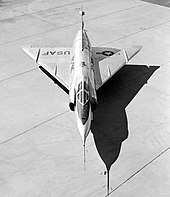
On 8 October 1948, the board of senior officers of the U.S. Air Force (USAF) made recommendations that the service organize a competition for a new interceptor scheduled to enter service in 1954; as such, the all-new design would initially be dubbed the "1954 Ultimate Interceptor".[3] Four months later, on 4 February 1949, the USAF approved the recommendation and prepared to hold the competition the following year. In November 1949, the Air Force decided that the new aircraft would be built around a fire-control system (FCS). The FCS was to be designed before the airframe to ensure compatibility.[4] The airframe and FCS together were called the weapon system.
In January 1950, the USAF Air Materiel Command issued request for proposals (RFPs) to 50 companies for the FCS, of which 18 responded. By May, the list was revised downward to 10. Meanwhile, a board at the U.S. Department of Defense headed by Major General Gordon P. Saville reviewed the proposals, and distributed some to the George E. Valley-led Air Defense Engineering Committee. Following recommendations by the committee to the Saville Board, the proposals were further reduced to two competitors, Hughes Aircraft and North American Aviation. Although the Valley Committee thought it was best to award the contract to both companies, Hughes was chosen by Saville and his team on 2 October 1950.[5][6]
Proposals for the airframe were issued on 18 June 1950, and in January 1951 six manufacturers responded.[7] On 2 July 1954, three companies, Convair, Republic and Lockheed won the right to build a mockup. Until then, Convair had done research into delta-winged aircraft, experimenting with different designs, two of which fell under the name P-92. Of the three, the best design was to win the production contract under the name "Project MX-1554". In the end, Convair emerged as the victor with its design, designated "XF-102", after Lockheed dropped out and Republic built only a mockup.[6] The development of three different designs was too expensive and in November, only Convair was allowed to continue with its Model 8-80.[8] To speed development, it was proposed to equip the prototypes and pre-production aircraft with the less-powerful Westinghouse J40 turbojet. Continued delays to the J67 and MA-1 (formerly "MX-1179")[9] FCS led to the decision to place an interim aircraft with the J40 and a simpler fire control system (dubbed "E-9") into production as the F-102A. The failure of the J40 led to the Pratt & Whitney J57 turbojet with afterburner, rated with 10,000 pounds-force (44 kN) of thrust[10] being substituted for the prototypes and F-102As.[11][12] This aircraft was intended to be temporary, pending the development of the F-102B, which would employ the more advanced Curtiss-Wright J67, a licensed derivative of the Bristol-Siddeley Olympus which was still in development.[13] The F-102B would later evolve to become the F-106A, dubbed the "Ultimate Interceptor".[10]
The prototype YF-102 made its first flight on 23 October 1953, at Edwards AFB, but was lost in an accident nine days later. The second aircraft flew on 11 January 1954, confirming a dismal performance. Transonic drag was much higher than expected, and the aircraft was limited to Mach 0.98 (i.e. subsonic), with a ceiling of 48,000 ft (14,630 m), far below the requirements.[14]
Major redesign
_on_ramp_E-2551.jpg)
To solve the problem and save the F-102, Convair embarked on a major redesign, incorporating the recently discovered area rule, while at the same time simplifying production and maintenance.[15] The redesign entailed lengthening the fuselage by 11 ft (3.35 m), being "pinched" at the midsection (dubbed the "Coke Bottle configuration"), with two large fairings on either side of the engine nozzle, with revised intakes and a new, narrower canopy. A more powerful model of the J57 was fitted, and the aircraft structure was lightened.[16][17]
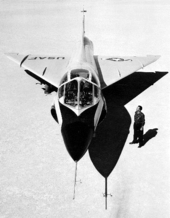
The first revised aircraft, designated YF-102A flew on 20 December 1954, 118 days after the redesign started, exceeding Mach 1 the next day.[17] The revised design demonstrated a speed of Mach 1.22 and a ceiling of 53,000 ft (16,154 m). These improvements were sufficient for the Air Force to allow production of the F-102, with a new production contract signed in March 1954.[18]
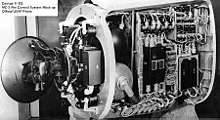
The production F-102A had the Hughes MC-3 fire control system, later upgraded in service to the MG-10. It had a three-segment internal weapons bay under the fuselage for air-to-air missiles. Initial armament was three pairs of GAR-1/2/3/4 (Later re-designated as AIM-4) Falcon missiles, which included both infrared homing and semi-active radar homing variants. The doors of the two forward bays each had tubes for 12 FFARs (for a total of 24) with initially 2 in (5.1 cm) being fitted and later 2.75 in (70 mm) replacing them. The F-102 was later upgraded to allow the carrying of up to two GAR-11/AIM-26 Nuclear Falcon missiles in the center bay.[19] The larger size of this weapon required redesigned center bay doors with no rocket tubes. Plans were considered to fit the MB-1 Genie nuclear rocket to the design, but although a Genie was test fired from a YF-102A in May 1956, it was never adopted.[20]
The F-102 received several major modifications during its operational lifetime, with most airframes being retrofitted with infrared search/tracking systems, radar warning receivers, transponders, backup artificial horizons, and improvements to the fire control system.[21] A proposed close-support version (never built) would have incorporated, in addition, an internal Gatling gun, an extra two hardpoints for bombs (in addition to the two underwing pylons for drop tanks that were fitted to all production F-102s), bigger internal fuel tanks, and an in-flight-refueling probe.[21]
To train F-102A pilots, the TF-102A trainer was developed, with 111 eventually manufactured. The aircraft was designed with side-by-side seating to facilitate pilot training, a popular concept in the 1950s (also used with the American Cessna T-37, British Hawker Hunter T.7 and English Electric Lightning T.4, among others). This required a redesign of the cockpit and a nose almost as wide as that of a Convair 340 commercial airliner. The new nose introduced buffeting the source of which was traced to the bulbous canopy. Vortex generators were added to the top of the canopy to prevent the buffet which had started at about Mach 0.72.[22] The intake ducts were revised as the inlets were repositioned. Despite the many changes, the aircraft was combat-capable, although this variant was predictably slower, reaching only subsonic speeds in level flight.[23]
The numerous inherent design and technical limitations of the F-102 led to a proposed successor, initially known as the F-102B "Ultimate Interceptor". The improved design, in which the proposed Curtiss-Wright J67 jet engine was eventually replaced by a Pratt & Whitney J75, underwent so many aerodynamic changes (including variable-geometry inlets) that it essentially became an entirely new aircraft and hence was redesignated and produced as the F-106 Delta Dart. Convair would also use a delta wing design in the Mach 2 class Convair B-58 Hustler bomber.
Operational history
Introduction to service
The first operational service of the F-102A was with the 327th Fighter-Interceptor Squadron at George Air Force Base,[20] in April 1956, and eventually a total of 889 F-102As were built, production ending in September 1958.[24] TF-102s and F-102s were used in the 1960s by the Air Defense Command (ADC) at Perrin AFB, Texas to train new F-102 pilots. They also provided platform training on flight characteristics of delta-winged aircraft for pilots who were destined to fly the B-58 Hustler bomber for the Strategic Air Command (SAC).
The F-102's official name, "Delta Dagger", was never used in common parlance, with the aircraft being universally known as the "Deuce." The TF-102 was known as the "Tub" because of its wider fuselage with side-by-side twin seating.
During the time the F-102A was in service, several new wing designs were used to experiment with the application of increased conical camber to the wings. Ultimately, a design was selected that actually increased elevon area, reduced takeoff speed, improved the supersonic L/D ratio and increased the aircraft's ceiling to 56,000 ft (17,069 m). A modification was required to the landing gear doors due to the wing redesign.
The Air Defense Command had F-102 Delta Daggers in service in 1960 and the type continued to serve in large numbers with both Air Force and Air National Guard units well into the 1970s. George W. Bush, later President of the United States, flew the F-102 in the 147th Fighter Interceptor Group based at Ellington AFB in Houston, Texas as part of his Texas Air National Guard service from 1968 to 1972.[25]
Vietnam War service
The F-102 served in the Vietnam War, flying fighter patrols and serving as bomber escorts. A total of 14 aircraft were lost in Vietnam: one to air-to-air combat,[26] several to ground fire and the remainder to accidents.
Initially, F-102 detachments began to be sent to bases in Southeast Asia in 1962 after radar contacts detected by ground radars were thought to possibly be North Vietnamese Il-28 "Beagle" bombers – considered to be a credible threat in that time period. The F-102s were sent to Thailand and other nearby countries to intercept these aircraft if they threatened South Vietnam.

Later on, Boeing B-52 Stratofortress strikes, codenamed "Arc Light", were escorted by F-102s based in the theater. It was during one of these missions that an F-102 was shot down by a North Vietnamese Mikoyan-Gurevich MiG-21 using an AA-2 Atoll heat-seeking missile. The MiGs approached undetected, and one of the F-102s was hit by an air-to-air missile, which did not explode immediately, but remained lodged in the aft end of the aircraft, causing stability problems. As the pilot reported the problem to his wingman, the wingman observed the damaged Delta Dagger explode in midair, killing the pilot.[27] This was the only air-to-air loss for the F-102 during the Vietnam War. The other F-102 pilot fired AIM-4 missiles at the departing MiG-21s, but no hit was recorded.
The F-102 was employed in the air-to-ground role with limited success, although neither the aircraft nor the training for its pilots were designed for that role. The 509th Fighter-Interceptor Squadron's Deuces arrived at Da Nang Air Base, 4 August 1964 from Clark Air Base, Philippines.[28] The interceptor was equipped with 24 2.75 in (70 mm) FFARs in the fuselage bay doors. These could be used to good effect against various types of North Vietnamese targets in daylight. At night it proved less dangerous to use heat-seeking Falcon missiles in conjunction with the F-102's nose-mounted IRST (Infrared Search & Track) on nighttime harassment raids along the Ho Chi Minh trail. Some F-102As were configured to accommodate a single AIM-26 Super Falcon in each side bay in lieu of the two conventional AIM-4 Falcons. Operations with both the F-102A and TF-102A two-seaters (which were used in a Forward Air Control role because its two seats and 2.75 in/70 mm rockets offered good versatility for the mission) continued in Vietnam until 1968 when all F-102s were returned to the United States.
| Date | F-102 model | Unit | Cause of loss/remarks |
|---|---|---|---|
| 27 November 1964 | F-102A | 509th Fighter-Interceptor Squadron (FIS) | Engine failure.[29] |
| 1 July 1965 | F-102A | 509th FIS (3) | (3) F-102As destroyed on the ground by enemy sappers at Da Nang Air Base.[30] |
| 15 December 1965 | F-102A | 509th FIS | Downed by ground fire while providing close air support (CAS).[31] |
| 19 August 1966 | F-102A | 509th FIS | Operational loss, crashed during night landing.[32] |
| 14 December 1966 | F-102A | 64th FIS | Downed by small arms fire within 60 seconds after takeoff.[33] |
| 15 January 1967 | TF-102A | 509th FIS | Operational loss, ferry mission.[34] |
| 2 April 1967 | F-102A | 509th FIS | Operational loss, engine failure. Also served with 16th & 64th FIS.[35] |
| 12 May 1967 | F-102A | 509th FIS | Destroyed during enemy ground attack; mortar fire at Biên Hòa Air Base.[36] |
| 3 February 1968 | F-102A | 509th FIS | Downed by MiG-21 K-13 (missile) at 36,000 feet.[37] |
| 16 July 1968 | F-102A | 509th FIS | Operational loss, engine failure.[38] |
| 16 September 1968 | F-102A | 509th FIS | Operational loss, ground collision after landing with an RF-4 Phantom II.[39] |
| 7 January 1969 | F-102A | 509th FIS | Operational loss, engine failure.[40] |

Later use
In 1973, six aircraft were converted to target drones as QF-102As and later PQM-102Bs (simulating MiG-21 threat aircraft) under a Full Scale Aerial Target (FSAT) project known as Pave Deuce.[41] Eventually, the program converted hundreds of F-102s for use as target drones for newer fighter aircraft, as well as testing of the U.S. Army's Patriot missile system.[42]
The F-102 and TF-102 were exported overseas to both Turkey and Greece. The Turkish F-102s saw combat missions during the 1974 Turkish invasion of Cyprus. There have been claims of air combat between Greek F-5s and Turkish F-102s above the Aegean Sea during the Turkish invasion. A Greek internet website editor, Demetrius Stergiou, claims that the Greek F-5s had shot down two Turkish F-102s, while the Turkish side has claimed that their F-102s had shot down two Greek F-5s;[43] however, both Greece and Turkey still officially deny any aircraft losses. The F-102 was finally retired from both of those air forces in 1979.
The F-102 left U.S. service in 1976, while the last QF-102A / PQM-102B drone was expended in 1986. No F-102s remain in flyable condition today, although many can be seen at museums or as permanent static displays as gate guardians at Air Force and Air National Guard installations.
Variants
- YF-102
- Prototypes. Non area-ruled fuselage. Powered by 14,500 lbf (64.5 kN) J57-P-11, two built.
- YF-102A
- Area-ruled prototypes. Powered by 16,000 lbf (71.2 kN) J57-P-23. Four converted from pre-production aircraft.
- F-102A
- Production Model. Initial eight pre-production aircraft built with non-area ruled fuselage. Remainder built (879) with area ruled fuselage.
- TF-102A
- Two-seat training version, 111 built.
- F-102B
- The original designation of the F-106A.
- F-102C
- Proposed tactical attack version with J57-P-47 engine. Two converted As, as YF-102C engineering test beds.[44]
- QF-102A
- Target drones converted from the F-102A. Six built.[45]
- PQM-102A
- Unpiloted target drones. 65 converted.[45]
- PQM-102B
- Revised target drone conversion, capable of being flown remotely or by pilot in cockpit. 146 converted.[45]
Operators
In 1969, Greece acquired 24 of these aircraft for use by the 114th Combat Wing at Tanagra Air Base. 19 of them were single-seat F-102As, five were two-seat TF-102As. They served with the Greek air force until 1977, when the F-102s were replaced by Mirage F1CG fighters. All aircraft were painted with ADC Grey and kept it until 1974. Since 1974 and thereafter they were painted with the «Vietnam» variation.[47]
Beginning in 1968, approximately 50 F-102As and TF-102As were transferred to Turkey from USAF stocks. Before transfer to Turkey, they were overhauled by CASA in Seville. They were initially assigned to the 191st Filo (Squadron) based at Murted, replacing the F-84F Thunderstreaks previously assigned to this unit. This unit was redesignated 142nd Filo in early 1973. In 1971, F-102s were also assigned to the 182nd Filo based at Diyarbakır, replacing the F-84Fs previously being flown by this unit. F-102s remained in service with these two squadrons until mid-1979, when they were replaced by the F-104G in the 142nd Filo and by the F-100C in the 182nd Filo.

- Air Defense Command / Aerospace Defense Command
- 2nd Fighter-Interceptor Squadron – Suffolk County AFB (1956–1959)
- 5th Fighter-Interceptor Squadron – Suffolk County AFB (1956–1960)
- 11th Fighter-Interceptor Squadron – Duluth AFB (1956–1960)
- 18th Fighter-Interceptor Squadron – Wurtsmith AFB (1957–1960)
- 27th Fighter-Interceptor Squadron – Griffiss AFB (1957–1959)
- 31st Fighter-Interceptor Squadron – Wurtsmith AFB (1956–1957); transferred to Alaska Air Command
- 37th Fighter-Interceptor Squadron – Ethan Allen AFB (1957–1960)
- 47th Fighter-Interceptor Squadron – Niagara Falls AFB (1958–1960)
- 48th Fighter-Interceptor Squadron – Langley AFB (1957–1960)
- 57th Fighter-Interceptor Squadron – Naval Station Keflavik (1962–1973)
- 59th Fighter-Interceptor Squadron – Goose Bay AFB(1960–1966)
- 61st Fighter-Interceptor Squadron – Truax Field (1957–1960)
- 64th Fighter-Interceptor Squadron – McChord AFB (1957–1960), Paine Field (1960–1966)
- 71st Fighter-Interceptor Squadron – Selfridge AFB (1958–1960)
- 76th Fighter-Interceptor Squadron – Westover AFB (1961–1963)
- 82d Fighter-Interceptor Squadron – Travis AFB (1957–1966)
- 86th Fighter-Interceptor Squadron – Youngstown AFB (1957–1960)
- 87th Fighter-Interceptor Squadron – Lockbourne AFB (1958–1960)
- 95th Fighter-Interceptor Squadron – Andrews AFB (1958–1959)
- 317th Fighter-Interceptor Squadron – McChord AFB (1957–1958)
- 318th Fighter-Interceptor Squadron – McChord AFB (1957–1960)
- 323d Fighter-Interceptor Squadron – Truax Field (1956–1957), Harmon AFB (1957–1960)
- 325th Fighter-Interceptor Squadron – Truax Field (1957–1966)
- 326th Fighter-Interceptor Squadron – Richards-Gebaur AFB (1957–1967)
- 327th Fighter-Interceptor Squadron – George AFB (1956–1958), Thule AB (1958–1960)
- 329th Fighter-Interceptor Squadron – George AFB (1958–1960)
- 331st Fighter-Interceptor Squadron – Webb AFB (1960–1963)
- 332nd Fighter-Interceptor Squadron – McGuire AFB (1957–1959), England AFB (1959–1960), Thule AB (1960–1965)
- 438th Fighter-Interceptor Squadron – Kincheloe AFB (1957–1960)
- 456th Fighter-Interceptor Squadron – Castle AFB (1958–1960)
- 460th Fighter-Interceptor Squadron – Portland AFB (1958–1966)
- 482nd Fighter-Interceptor Squadron – Seymour Johnson AFB (1956–1965)
- 498th Fighter-Interceptor Squadron – Geiger Field (1957–1959)
- Alaskan Air Command
- 317th Fighter-Interceptor Squadron – Elmendorf AFB (1958–1970)
- 31st Fighter-Interceptor Squadron – Elmendorf AFB (1957–1958)
- United States Air Forces in Europe
- 32d Fighter-Interceptor Squadron – Soesterberg AB (1960–1969)
- 431st Fighter-Interceptor Squadron – Zaragosa AB (1960–1964)
- 496th Fighter-Interceptor Squadron – Hahn AB (1960–1970)
- 497th Fighter-Interceptor Squadron – Torrejon AB (1960–1963)
- 525th Fighter-Interceptor Squadron – Bitburg AB (1959–1969)
- 526th Fighter-Interceptor Squadron – Ramstein AB (1960–1970)
- Pacific Air Forces
- 4th Fighter-Interceptor Squadron – Misawa AB (1957–1965)
- 16th Fighter-Interceptor Squadron – Naha AB (1959–1965)
- 40th Fighter-Interceptor Squadron – Yokota AB (1957–1965)
- 64th Fighter-Interceptor Squadron – Clark AB (1966–1969)
- 68th Fighter-Interceptor Squadron – Itazuke AB (1957–1965)
- 82d Fighter-Interceptor Squadron – Naha AB (1966–1971)
- 509th Fighter-Interceptor Squadron – Clark AB (1959–1970)
- Air National Guard
- 102d Fighter-Interceptor Squadron, NY ANG – Suffolk County ANGB (1972–1975)
- 111th Fighter-Interceptor Squadron, TX ANG – Ellington Field (1960–1975)
- 116th Fighter-Interceptor Squadron, WA ANG – Geiger Field (1965–1969)
- 118th Fighter-Interceptor Squadron, CT ANG – Bradley ANGB (1966–1971)
- 122nd Fighter-Interceptor Squadron, LA ANG – NAS New Orleans (1960–1971)
- 123d Fighter-Interceptor Squadron, OR ANG – Portland ANGB (1966–1971)
- 132nd Fighter-Interceptor Squadron, ME ANG – Bangor ANGB (1969–1970)
- 134th Fighter-Interceptor Squadron, VT ANG – Burlington ANGB (1965–1975)
- 146th Fighter-Interceptor Squadron, PA ANG – Pittsburgh AP (1961–1975)
- 151st Fighter-Interceptor Squadron, TN ANG – McGhee-Tyson ANGB (1963–1964)
- 152d Fighter-Interceptor Squadron, AZ ANG – Tucson ANGB (1966–1969)
- 157th Fighter-Interceptor Squadron, SC ANG – MacEntire ANGB (1963–1975)
- 159th Fighter-Interceptor Squadron, FL ANG – Imeson Field (1960–1968), Jacksonville ANGB 1968–1974
- 175th Fighter-Interceptor Squadron, SD ANG – Sioux Falls AFB (1960–1970)
- 176th Fighter-Interceptor Squadron, WI ANG – Truax Field (1966–1974)
- 178th Fighter-Interceptor Squadron, ND ANG – Hector Field (1966–1969)
- 179th Fighter-Interceptor Squadron, MN ANG – Duluth ANGB (1966–1971)
- 182nd Fighter-Interceptor Squadron, TX ANG – Kelly AFB (1960–1969)
- 186th Fighter-Interceptor Squadron, MT ANG – Great Falls ANGB (1966–1972)
- 190th Fighter-Interceptor Squadron, ID ANG – Gowen Field (1964–1975)
- 194th Fighter-Interceptor Squadron, CA ANG – Fresno ANGB (1964–1974)
- 196th Fighter-Interceptor Squadron, CA ANG – Ontario IAP (1965–1975)
- 199th Fighter-Interceptor Squadron, HI ANG – Hickam AFB (1960–1977)
Aircraft on display
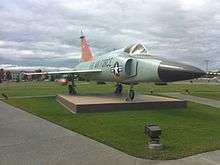
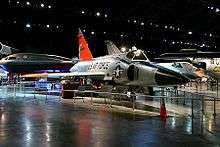
Canada
- F-102A
- 56-1266 – Stephenville, Newfoundland. This aircraft was formerly of the U.S. 59th Fighter Interceptor Squadron, Goose Bay (Happy Valley), Labrador.[49]
Greece
- F-102A
- TF-102A
- 56-2355 – Hellenic Air Force Museum Tatoi[52]
- 55-4035 = Hellenic Air Force Museum Tatoi.[53]
Netherlands
- F-102A
- Registration unknown - On display at the Nationaal Militair Museum, Soesterberg. Former Greek aircraft, painted as 56-1032, 32nd FIS USAF.[54]
Turkey
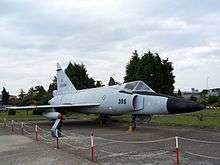
- F-102A
- 55-3386 – Istanbul Aviation Museum.[55]
- TF-102A
- 56-2368 – Istanbul Aviation Museum.[56]
United States
- YF-102A
- 53-1787 – Air Park at Jackson Barracks Military Museum, New Orleans, Louisiana[57]
- 53-1788 – Carolinas Aviation Museum, Charlotte, North Carolina.[58]
- TF-102A
- 54-1351 – Selfridge Military Air Museum, Selfridge ANGB, Mount Clemens, Michigan.[59]
- 54-1353 – Century Circle at Edwards Air Force Base, near Rosamond, California[60]
- 54-1366 – Pima Air and Space Museum adjacent to Davis-Monthan AFB in Tucson, Arizona.[61]
- 56-2317 – Grissom Air Museum, Grissom Air Reserve Base (former Grissom AFB), Peru, Indiana.[62]
- 56-2337 – Fort Worth Aviation Museum, Fort Worth, Texas.[63]
- 56-2346 – Pennsylvania National Guard Military Museum, Pennsylvania National Guard Headquarters, Fort Indiantown Gap, Pennsylvania. (Aircraft was assigned to the Pennsylvania Air National Guard, at the 112th Fighter Interceptor Group, Pittsburgh International Airport, Coraopolis, Pennsylvania from 1960–1974 and is on loan from the National Museum of the United States Air Force).[64]
- 56-2352 – Southern Museum of Flight, Birmingham, Alabama.[65]
- 56-2353 – Wisconsin National Guard Memorial Library and Museum, Volk Field, Camp Douglas, Wisconsin.[66]
- 56-2364 – Castle Air Museum, Atwater, California.[67]
- F-102A
- 53-1801 – Joe Foss Field Air National Guard Station - 114th Fighter Wing, Sioux Falls, South Dakota.[68]
- 53-1804 – Fresno Air National Guard Base - 144th Fighter Wing, Fresno, California.[69]
- 53-1816 – Boise Idaho Military History Museum, Boise, Idaho.[70]
- 54-1405 – Strategic Air and Space Museum, Ashland, Nebraska[71]
- 54-1373 – Hickam AFB, Honolulu, Hawaii.[72]
- 55-3366 – Pacific Aviation Museum, Ford Island, Honolulu, Hawaii.[73]
- 56-0984 – Wings Over the Rockies Museum, (former Lowry AFB) Denver, Colorado.[74]
- 56-0985 – McEntire Air National Guard Base, South Carolina[75]
- 56-0986 – MAPS Air Museum, Akron-Canton Regional Airport, Ohio.[76]
- 56-1017 – South Dakota Air and Space Museum, Ellsworth AFB, Rapid City, South Dakota.[77]
- 56-1053, (painted as 56-1274), – Alaska Heritage Park, Elmendorf AFB, Alaska.[78]
- 56-1105 – Lions Park in Great Falls, Montana.[79]
- 56-1109 – Peterson AFB, Colorado Springs, Colorado.[80]
- 56-1114 – March Field Air Museum, March ARB (former March AFB), Riverside, California.[81]
- 56-1115 – Fairchild AFB, Spokane, Washington.[82]
- 56-1134 – Arizona ANGB, Tucson, Arizona.[83]
- 56-1140 – Aerospace Museum of California, former McClellan AFB, Sacramento, California.[84]
- 56-1151 – Museum of Aviation, Robins AFB, Warner Robins, Georgia.[85]
- 56-1219 – Empire State Aerosciences Museum, Schenectady County Airport, New York.[86]
- 56-1252 – Ellington Field Joint Reserve Base, Houston, Texas. Future President of the United States George W. Bush flew this model with the 147th Fighter Interceptor Group, 111th Fighter Interceptor Squadron of the Texas Air National Guard in the early 1970s. It is mounted on a pole that exits the burner. His name is on the canopy.[87]
- 56-1264 – Connecticut ANGB - 103rd FW, Windsor Locks, Connecticut.[88]
- 56-1268 – San Diego Air and Space Museum, Gillespie Field, El Cajon, California.[89]
- 56-1273 – Wisconsin National Guard Memorial Library and Museum, Volk Field, Camp Douglas, Wisconsin.[90]
- 56-1282 – Transportation and Industry Museum of Alaska, Wasilla, Alaska.[91]
- 56-1325, (painted as 56-1476), – Minnesota Air National Guard Base, Minneapolis, Minnesota[92]
- 56-1368 – Evergreen Aviation Museum, McMinnville, Oregon.[93]
- 56-1393 – Pima Air and Space Museum adjacent to Davis-Monthan AFB in Tucson, Arizona.[94]
- 56-1413 – Castle Air Museum (former Castle AFB), Atwater, California.[95]
- 56-1415 – Pittsburgh IAP Air Reserve Station (located at Pittsburgh International Airport), Pittsburgh, Pennsylvania. Refurbished in 2010[96]
- 56-1416 – National Museum of the United States Air Force, Wright-Patterson Air Force Base near Dayton, Ohio.[97]
- 56-1427 – Travis AFB Heritage Center, Travis AFB, Fairfield, California.[98]
- 56-1502, (painted as 55-3432), - North Dakota ANGB - 119TH FG, Fargo, North Dakota.[99]
- 56-1505 – Minot AFB, Minot, North Dakota.[100]
- 56-1515 – McChord Air Museum, McChord Air Force Base, Washington.[101]
- 57-0788 – Long Island MacArthur Airport, Long Island, New York.[102]
- 57-0817, (painted as 56-1357), - Florida Air National Guard Base - 125th Fighter Wing, Jacksonville, Florida.[103]
- 57-0826 – Sheppard AFB, Wichita Falls, Texas.[104]
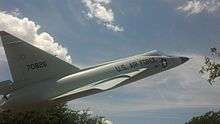
- 57-0833 – Hill Aerospace Museum, Hill AFB, Utah.[105]
- 57-0858 – Burlington Air National Guard Base, Burlington, Vermont.[106]
- 57-0906 – Museum of Aviation, Warner Robins AFB, Macon, Georgia.[107]
Specifications (F-102A)

Data from The Great Book of Fighters[108]
General characteristics
- Crew: 1
- Length: 68 ft 4 in (20.83 m)
- Wingspan: 38 ft 1 in (11.61 m)
- Height: 21 ft 2.5 in (6.464 m)
- Wing area: 695 sq ft (64.6 m2) conically cambered wing
- 661.5 sq ft (61.46 m2) YF-102
- Airfoil: NACA 0004-65 mod[109]
- Empty weight: 19,350 lb (8,777 kg)
- Gross weight: 24,494 lb (11,110 kg)
- Max takeoff weight: 31,500 lb (14,288 kg)
- Fuel capacity: 1,085 US gal (903 imp gal; 4,110 l) internal + 2x 215 US gal (179 imp gal; 810 l) drop tanks
- Powerplant: 1 × Pratt & Whitney J57-P-25 afterburning turbojet engine, 11,700 lbf (52 kN) thrust dry, 17,000 lbf (76 kN) with afterburner
Performance
- Maximum speed: 825 mph (1,328 km/h, 717 kn) at 40,000 ft (12,192 m)
- Maximum speed: Mach 1.25
- Range: 1,350 mi (2,170 km, 1,170 nmi)
- Service ceiling: 53,400 ft (16,300 m)
- Rate of climb: 13,000 ft/min (66 m/s)
- Wing loading: 35 lb/sq ft (170 kg/m2)
- Thrust/weight: 0.7
Armament
- Rockets: 24 × 2.75 in (70 mm) FFAR (Folding Fin Aerial Rocket) unguided rockets in missile bay doors
- Missiles:
- 6 × AIM-4 Falcon air-to-air missiles or
- 3 × AIM-4 Falcon
- 1 × AIM-26 Falcon with conventional or nuclear warhead
Avionics
- Hughes MG-10 fire control system
See also
Related development
Aircraft of comparable role, configuration and era
- Avro Canada CF-105 Arrow
- Dassault Mirage III
- English Electric Lightning
- Mikoyan-Gurevich MiG-21/Chengdu J-7
- Saab 35 Draken
- Sukhoi Su-9/Su-11
- Sukhoi Su-15
Related lists
References
Notes
- The USAF retired its F-102s from service in 1976, followed by both Greece and Turkey in 1979. The USAF F-102s remained as target drones until 1986.
- It appears that the aircraft was originally intended to be named Machete;[2] it is unclear when the Delta Dagger name was adopted.
Citations
- Knaack 1978, p. 169.
- Aircraft Recognition Manual, Supplement No. 5 (Army Field Manual), Volume FM 30-30, June 1954, p. 11. Washington, D.C.: United States Department of Defense.
- Donald, general editor, David (1997). The encyclopedia of world aircraft (Updated ed.). Leicester: Blitz Editions. p. 207. ISBN 1-85605-375-X.
- Donald 2003, pp. 68–69.
- Donald 2003, p. 228.
- Donald 2003, p. 69.
- Baugher, Joseph F. "Convair YF-102". JoeBaugher.com. Joseph F. Baugher. Archived from the original on 26 July 2014. Retrieved 16 July 2014.
- Becker, text by W.D. (2012). Supersonic eagles : the Century Series fighters (1st ed.). Clinton Township, MI: Inland Expressions. p. 72. ISBN 0981815790.
- Wegg 2000, p. 200.
- Donald 2003, p. 70.
- Wegg 2000, pp. 200–201.
- Knaack 1978, pp. 160–161.
- Knaack 1978, pp. 159–160.
- Knaack 1978, pp. 163–164.
- Baals, Donald D. "WIND TUNNELS OF NASA. Chapter 5 - The Era of High-Speed Flight. The Area Rule and the F-102 Story". history.nasa.gov/. US Library of Congress, Supt. of Docs. no.: NAS 1.21:440. Archived from the original on 7 June 2013. Retrieved 16 July 2014.
- Gunston 1957, pp. 513–514.
- Wegg 2000, p. 201.
- Knaack 1978, p. 166.
- "AIM-26A." Archived 25 March 2015 at the Wayback Machine wikimedia.org. Retrieved: 27 October 2010.
- Peacock 1986, p. 34.
- "Taylor 1995, pp. 92–93.
- Test Pilot Testing the Century Series ofjet fighters at Edwards Air Force Base during the 1950s, Edited by Harry P. Schmidt 1997, Mach 2 Books, PO Box 107, Shelton CT06484, p.95
- Gunston 1981, p. 26.
- Peacock 1986, pp. 34–35.
- "George Walker Bush (1946– )." Archived 11 February 2010 at the Wayback Machine millercenter.org. Retrieved: 27 October 2010.
- Hobson 2001, p. 269.
- Hobson 2001, p. 271.
- Poss, Don. "Yates, Ron: Vietnam Remembrances." Archived 26 May 2011 at the Wayback Machine vspa.com. Retrieved: 27 October 2010.
- Hobson 2001, p. 13.
- Hobson 2001, p. 24.
- Hobson 2001, p. 42.
- Hobson 2001, p. 71.
- Hobson 2001, p. 83.
- Hobson 2001, p. 86.
- Hobson 2001, p. 94.
- Hobson 2001, p. 100.
- Hobson 2001, p. 135.
- Hobson 2001, p. 155.
- Hobson 2001, p. 162.
- Hobson 2001, p. 171.
- Knaack 1978, p. 170.
- "F-102 Drones". www.joebaugher.com. Archived from the original on 25 September 2017. Retrieved 28 April 2018.
- Stergiou, Demetrius."The Shooting Down of the Turkish F-102s" Archived 5 November 2008 at the Wayback Machine (translation and verbatim by Nicholas Tselepidis). Cyprus 1974: Greek Point of View via acig.org, 28 October 2003. Retrieved: 27 October 2010.
- Baugher, Joe. "Convair F-102C." Archived 24 November 2010 at the Wayback Machine USAAC/USAAF/USAF Fighter and Pursuit Aircraft: Original Fighter Series-1922 to 1962, 4 December 1999. Retrieved: 25 March 2011.
- Wegg 2000, p. 203.
- Baugher, Joe. "F-102s with Greece and Turkey." Archived 5 June 2012 at the Wayback Machine USAAC/USAAF/USAF Fighter and Pursuit Aircraft: Original Fighter Series-1922 to 1962, 4 December 1999. Retrieved: 9 October 2011.
- Hellenic Air Force - Convair F-102A Delta Dagger Retrieved 20 July 2020
- Baugher, Joe. "Squadron Service of F-102A" Archived 24 November 2010 at the Wayback Machine USAAC/USAAF/USAF Fighter and Pursuit Aircraft: Original Fighter Series-1922 to 1962, 14 February 2004. Retrieved: 9 October 2011.
- "F-102 Delta Dagger/56-1266." Archived 6 October 2012 at the Wayback Machine Warbird Registry. Retrieved: 24 March 2011.
- "F-102 Delta Dagger/56-1106." Archived 2 October 2013 at the Wayback Machine planespotters.net. Retrieved: 9 October 2011.
- "F-102 Delta Dagger/56-1232." Archived 15 October 2011 at the Wayback Machine Larisa Base Museum. aviationmuseum.eu. Retrieved: 9 October 2011.
- "F-102 Delta Dagger / 56-1032." Archived 15 October 2017 at the Wayback Machine nmm.nl. Retrieved: 14 October 2017.
- "F-102 Delta Dagger/55-3386." Archived 28 September 2012 at the Wayback Machine Warbird Registry. Retrieved: 9 October 2011.
- "F-102 Delta Dagger/56-2386." Archived 29 September 2012 at the Wayback Machine Warbird Registry. Retrieved: 9 October 2011.
- "F-102 Delta Dagger/53-1787." Archived 30 January 2015 at Wikiwix aerialvisuals.ca Retrieved: 27 January 2015.
- "F-102 Delta Dagger/53-1178." Archived 28 April 2018 at the Wayback Machine aerialvisuals.ca Retrieved: 27 January 2015.
- "F-102 Delta Dagger/54-1351." Archived 19 August 2016 at the Wayback Machine Selfridge Military Air Museum. Retrieved: 16 June 2015.
- "F-102 Delta Dagger/54-1353." Archived 22 October 2014 at the Wayback Machine Air Force Flight Test Center Museum. Retrieved: 27 January 2015.
- "F-102 Delta Dagger/54-1366." Archived 24 February 2015 at the Wayback Machine Pima Air and Space Museum. Retrieved: 27 January 2015.
- "F-102 Delta Dagger/56-2317." Archived 15 January 2013 at the Wayback Machine Grissom Air Museum. Retrieved: 24 March 2011.
- "F-102 Delta Dagger/56-2337." Archived 7 May 2015 at the Wayback Machine Fort Worth Aviation Museum. Retrieved: 27 January 2015.
- "F-102 Delta Dagger/56-2346." Archived 4 October 2011 at the Wayback Machine Pennsylvania National Guard Museum, Retrieved: 9 October 2011.
- "F-102 Delta Dagger/56-2352." Archived 8 April 2002 at the Wayback Machine Southern Museum of Flight. Retrieved: 27 January 2015.
- "F-102 Delta Dagger/56-2353." Archived 5 September 2015 at Wikiwix aerialvisuals.ca Retrieved: 16 June 2015.
- "F-102 Delta Dagger/56-2364." Archived 14 November 2016 at the Wayback Machine Castle Air Museum. Retrieved: 56-2364.
- "F-102 Delta Dagger/53-1801." Archived 16 June 2015 at Wikiwix aerialvisuals.ca Retrieved: 16 June 2015.
- "F-102 Delta Dagger/53-1804." Archived 17 June 2015 at the Wayback Machine aerialvisuals.ca Retrieved: 16 June 2015.
- "F-102 Delta Dagger/53-1816." Archived 18 June 2015 at Wikiwix aerialvisuals.ca Retrieved: 16 June 2015.
- "F-102 Delta Dagger/54-1405." Archived 14 January 2015 at the Wayback Machine Strategic Air and Space Museum. Retrieved: 27 January 2015.
- "F-102 Delta Dagger/54-1373." Archived 19 June 2015 at Wikiwix aerialvisuals.ca Retrieved: 16 June 2015.
- "F-102 Delta Dagger/55-3366." Archived 6 May 2015 at the Wayback Machine Pacific Aviation Museum. Retrieved: 16 June 2015.
- "F-102 Delta Dagger/56-0984." Archived 17 February 2015 at the Wayback Machine Wings Over the Rockies Air and Space Museum. Retrieved: 27 January 2015.
- "F-102 Delta Dagger/56-0985." Archived 28 January 2015 at Wikiwix aerialvisuals.ca Retrieved: 27 January 2015.
- "F-102 Delta Dagger/56-0985." Archived 10 October 2013 at the Wayback Machine MAPS Air Museum. Retrieved: 7 November 2012.
- "F-102 Delta Dagger/56-1017." Archived 6 August 2017 at the Wayback Machine South Dakota Air and Space Museum. Retrieved: 16 June 2015.
- "F-102 Delta Dagger/56-1053." Archived 28 January 2015 at Wikiwix aerialvisuals.ca Retrieved: 27 January 2015.
- "F-102 Delta Dagger/56-1105." Archived 28 January 2015 at Wikiwix aerialvisuals.ca Retrieved: 27 January 2015.
- "F-102 Delta Dagger/56-1109." Archived 30 January 2015 at Wikiwix aerialvisuals.ca Retrieved: 27 January 2015.
- "F-102 Delta Dagger/56-1114." Archived 13 January 2015 at the Wayback Machine March Field Museum. Retrieved: 27 January 2015.
- "F-102 Delta Dagger/56-1115." Archived 17 June 2015 at Wikiwix aerialvisuals.ca Retrieved: 16 June 2015.
- "F-102 Delta Dagger/56-1134." Archived 17 June 2015 at Wikiwix aerialvisuals.ca Retrieved: 16 June 2015.
- "F-102 Delta Dagger/56-1140." Archived 17 December 2014 at the Wayback Machine Aerospace Museum of California. Retrieved: 27 January 2015.
- "F-102 Delta Dagger/56-1151." Archived 3 December 2012 at the Wayback Machine Museum of Aviation. Retrieved: 9 February 2015.
- "F-102 Delta Dagger/56-1219." Archived 3 October 2013 at the Wayback Machine aerialvisuals.ca Retrieved: 27 September 2013.
- "F-102 Delta Dagger/56-1252." Archived 29 January 2015 at Wikiwix aerialvisuals.ca Retrieved: 27 January 2015.
- "F-102 Delta Dagger/56-1264." Archived 3 July 2015 at Wikiwix aerialvisuals.ca Retrieved: 16 June 2015.
- "F-102 Delta Dagger/56-1268." Archived 28 January 2015 at Wikiwix aerialvisuals.ca Retrieved: 27 January 2015.
- "F-102 Delta Dagger/56-1273." Archived 5 September 2015 at Wikiwix aerialvisuals.ca Retrieved: 16 June 2015.
- "F-102 Delta Dagger/56-1282." Archived 30 January 2018 at the Wayback Machine airport-data.com Retrieved: 29 January 2018.
- "F-102 Delta Dagger/56-1325." Archived 17 June 2015 at the Wayback Machine The Minnesota Air National Guard Museum. Retrieved: 27 January 2015.
- "F-102 Delta Dagger/56-1386." Archived 6 December 2011 at the Wayback Machine Evergreen Aviation Museum. Retrieved: 9 October 2011.
- "F-102 Delta Dagger/56-1393." Archived 4 January 2015 at the Wayback Machine Pima Air and Space Museum. Retrieved: 27 January 2015.
- "F-102 Delta Dagger/56-1413." Archived 14 November 2016 at the Wayback Machine Castle Air Museum. Retrieved: 27 January 2015.
- "F-102 Delta Dagger/56-1415." Archived 30 January 2015 at Wikiwix aerialvisuals.ca Retrieved: 27 January 2015.
- "F-102 Delta Dagger/56-1416." Archived 5 January 2017 at the Wayback Machine National Museum of the United States Air Force. Retrieved: 23 August 2015.
- "F-102 Delta Dagger/56-1427." Archived 5 June 2015 at the Wayback Machine Travis AFB Heritage Center. Retrieved: 16 June 2015.
- "F-102 Delta Dagger/56-1502." Archived 17 June 2015 at Wikiwix aerialvisuals.ca Retrieved: 16 June 2015.
- "F-102 Delta Dagger/56-1505." Archived 18 June 2015 at Wikiwix aerialvisuals.ca Retrieved: 16 June 2015.
- "F-102 Delta Dagger/56-1515." Archived 29 May 2008 at the Wayback Machine McChord Air Museum. Retrieved: 12 October 2010.
- "F-102 Delta Dagger/57-0788." Archived 13 October 2016 at the Wayback Machine aerialvisuals.ca Retrieved: 27 January 2015.
- "F-102 Delta Dagger/57-0817." Archived 18 June 2015 at Wikiwix aerialvisuals.ca Retrieved: 16 June 2015.
- "F-102 Delta Dagger/57-0826." Archived 26 July 2015 at Wikiwix aerialvisuals.ca Retrieved: 16 June 2015.
- "F-102 Delta Dagger/57-0833." Archived 7 October 2012 at the Wayback Machine Hill Aerospace Museum. Retrieved: 9 October 2011.
- "F-102 Delta Dagger/57-0858." Archived 28 January 2015 at Wikiwix aerialvisuals.ca Retrieved: 27 January 2015.
- "F-102 Delta Dagger/57-0906." Archived 19 June 2015 at Wikiwix aerialvisuals.ca Retrieved: 16 June 2015.
- Green, William and Gordon Swanborough. The Great Book of Fighters. St. Paul, Minnesota: MBI Publishing, 2001. ISBN 0-7603-1194-3.
- Lednicer, David. "The Incomplete Guide to Airfoil Usage". m-selig.ae.illinois.edu. Retrieved 16 April 2019.
Bibliography
- Donald, David. "Convair F-102 Delta Dagger". Century Jets:USAF Frontline Fighters of the Cold War. London: AIRtime Publishing Inc., 2003. ISBN 1-880588-68-4.
- Drendel, Lou. Century Series in Color (Fighting Colors). Carrollton, Texas: Squadron/Signal Publications, 1980. ISBN 0-89747-097-4.
- Green, William. The World's Fighting Planes. London: Macdonald, 1964.
- Gunston, Bill. "Convair F-102: An Analysis of America's Home-defence Interceptor". Flight, 19 April 1957, pp. 512–518.
- Gunston, Bill. Fighters of the Fifties. North Branch, Minnesota: Specialty Press Publishers & Wholesalers, Inc., 1981. ISBN 0-933424-32-9.
- Hobson, Chris. Vietnam Air Losses: United States Air Force, Navy and Marine Corps Fixed-Wing Aircraft Losses in Southeast Asia, 1961–73. North Branch, Minnesota: Specialty Press, 2001. ISBN 1-85780-115-6.
- Jenkins, Dennis R. and Tony R. Landis. Experimental & Prototype U.S. Air Force Jet Fighters. North Branch, Minnesota, USA: Specialty Press, 2008. ISBN 978-1-58007-111-6.
- Knaack, Marcelle Size. Encyclopedia of US Air Force Aircraft and Missile Systems: Volume 1, Post-World War II Fighters, 1945–1973 (PDF). Washington, D.C.: Office of Air Force History, 1978. ISBN 0-912799-59-5.
- Pace, Steve. X-Fighters: USAF Experimental and Prototype Fighters, XP-59 to YF-23. St. Paul, Minnesota: Motorbooks International, 1991. ISBN 0-87938-540-5.
- Peacock, Lindsay. "Convair's Delta Defender: The F-102 Story". Air International, Vol. 30, No. 1, January 1986, pp. 28–37, 52. ISSN 0306-5634.
- Taylor, Michael J. H., ed. "The Convair Delta Dagger". Jane's American Fighting Aircraft of the 20th Century. New York: Modern Publishing, 1995. ISBN 978-0-7924-5627-8.
- Wegg, John. General Dynamics Aircraft and their Predecessors. London: Putnam, 1990. ISBN 0-85177-833-X.
- Winchester, Jim, ed. "Convair F-102 Delta Dagger." Military Aircraft of the Cold War (The Aviation Factfile). London: Grange Books plc, 2006. ISBN 1-84013-929-3.
External links
| Wikimedia Commons has media related to F-102 Delta Dagger. |